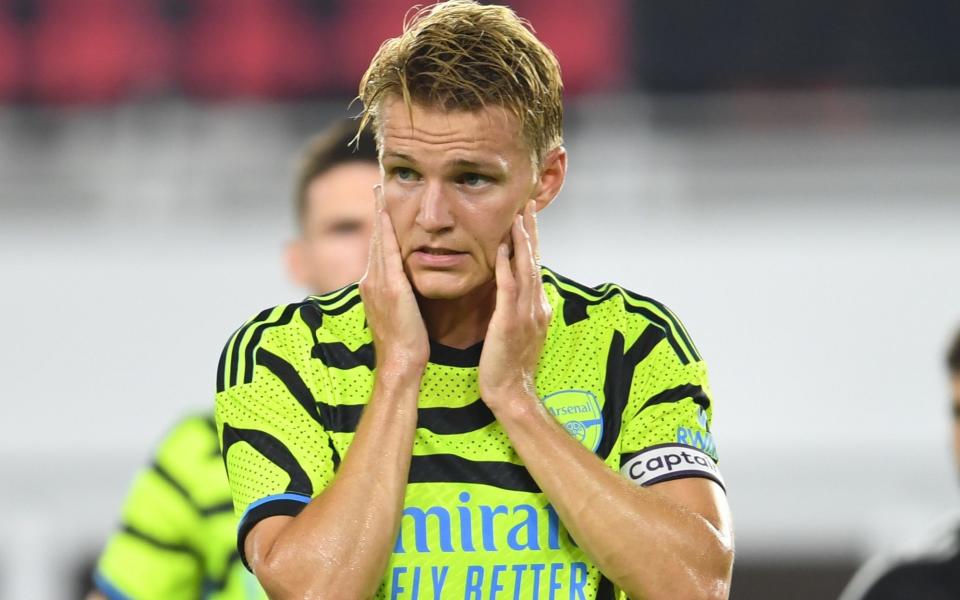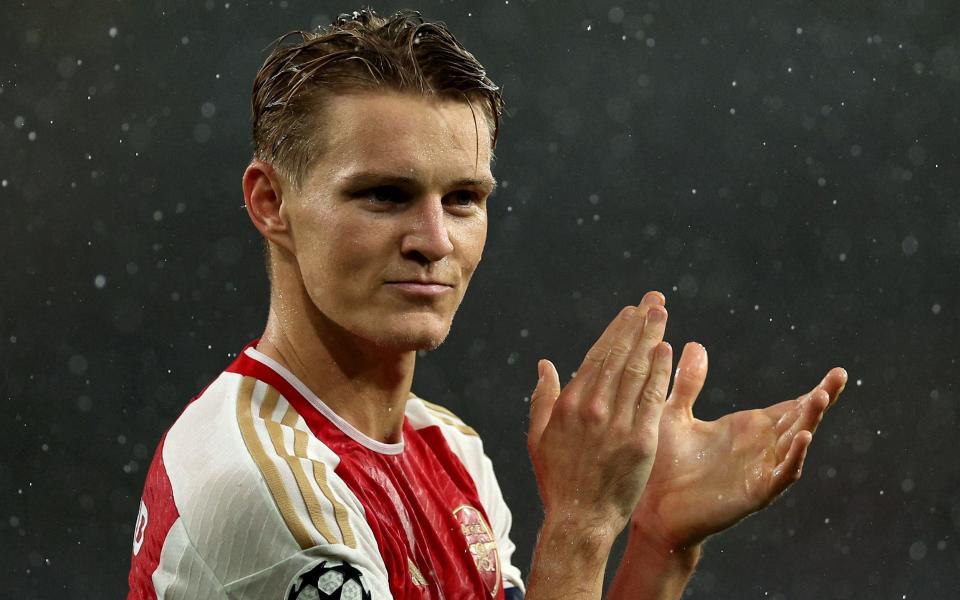The data that show Martin Odegaard is victim of Arsenal’s defensive shift

The cross was delivered by Bukayo Saka, and the finishing touch was provided by Kai Havertz, but Arsenal’s winner at Brentford would never have materialised without the work of Martin Odegaard in the build-up.
The Arsenal captain did not receive any plaudits for his role in the 89th-minute strike. Naturally, the headline writers all focused on Havertz. But to watch the goal back is to see how the little details, and the subtle decision taken by Odegaard, made all the difference as Arsenal sought victory in west London.
Receiving the ball on the edge of Brentford’s penalty area, Odegaard had the option of a simple pass to Saka on the right. Instead of playing it immediately, though, he delayed. Dribbling into the box, Odegaard attracted two opponents towards him. Only then did he play the pass, after creating enough space for Saka to produce the match-winning cross.
It was hardly the most eye-catching moment of Odegaard’s Arsenal career, but it did matter to the result. It must have mattered to Odegaard, too, to play an important part in such a significant moment in Arsenal’s season, especially after enduring a challenging few months on a personal level.
A challenging few months? That might sound a little odd, given his recently signed new contract and Arsenal’s position at the summit of the league table. But for Odegaard the individual, this campaign has presented more difficulties than he, or Mikel Arteta, might have expected.
First, with regard to fitness. Last year he missed only one Premier League game, starting 37 of 38 matches. This season, as a result of a hip injury and a concussion, he has already missed three. Before the hip injury ruled him out of action, he had played through the pain of it for weeks.

Second, with regard to the evolution of Arsenal as a team. Arteta’s side are not the same as this time last year, when they surfed to the top of the table on a wave of fast-paced, attacking football. They are more sensible now: Saturday’s victory at Brentford was their fourth 1-0 win of the league campaign, compared to just three 1-0 wins last season.
Arsenal’s shift towards a more controlled, less chaotic approach has made life more difficult for their chief playmaker. The 24-year-old has been arguably the biggest victim of their stylistic transformation, which is largely due to the changes in approach from opposition defences.
There are a few factors at play. The first is that Arsenal’s attackers simply have less space than they did last season. Opponents are sitting deeper, with more players behind the ball, and Odegaard is more tightly marked than ever.
“It is not going to be as fluent, it is not going to be as hectic,” Arteta said. “Because there is no space to run. When you’re sitting in traffic I want to go 100 miles an hour but I have three buses and 55 taxis and motorbikes around me, so it’s tricky.”
An indication of the lack of available space behind the opposition defence is that, this season, Odegaard has played only one successful through ball in the league, from six attempts. Last season, he completed 13 successful through balls from 25 attempts.
Against packed defences, Odegaard is seeing less of the ball in dangerous areas. As a result he is creating fewer chances, shooting less frequently and, in that heavy traffic, making fewer passes to his team-mates in the penalty box.
Another key issue is that Arsenal have struggled to score early goals. A major reason for their matches being so open last season was their propensity for striking in the first few minutes, therefore forcing the opposition to be more aggressive.
The drop-off in early goals has been enormous. In 2022/23, Arsenal scored 19 league goals within the first 20 minutes of matches (22 per cent of their total tally). This season, in 13 matches, they have scored just one goal within the first 20 minutes (four per cent of their total tally).
“Last year, we scored a lot of goals in the first minutes of the games,” Arteta said. “Then the game becomes different.”
It is surely no coincidence that, on the one occasion they did score early in the league – against Bournemouth in September – Odegaard produced a masterful display. Similarly, he was majestic against PSV Eindhoven in the Champions League. On that night, Arsenal were two goals ahead by the 21st minute.
A third factor is the change in personnel in Arsenal’s midfield. Granit Xhaka has been replaced by Kai Havertz, while Thomas Partey’s position at the base of midfield now belongs to Declan Rice, the £105 million arrival from West Ham United.
Rice has been sensational for Arsenal but he is yet to replicate Partey’s understanding of Odegaard’s movement. A crucial part of Arsenal’s approach last season was Partey’s ability to fizz passes into Odegaard’s feet – he did so, on average, 8.5 times per match. This year, Rice has found Odegaard an average of just 5.2 times per match.
The old saying about class being permanent will no doubt prove to be true in the case of Odegaard, who has done as much as any player to change Arsenal into a team capable of challenging for the league. He will continue to be a major influence for his club, captain’s armband around his bicep, but he might have to do so in a different, less spectacular way.
“He is a player that is so intelligent,” Arteta said. “He will find a way, at the end, to win the game for us.”

